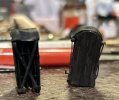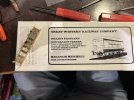Mike Garwood
Western Thunderer
All the coach corridor connectors have been completed. Hopefully I’ve got the width right for the coach couplings so that the ends of the coach spring against each other. Time will tell.

Next up is a GWR Grange 6810 – Blakemere Grange. I have a photo of her blasting thru HHL with a freight train and a photo of her with coaches having just left Pontypool Road. I’m not the owner of these photos and I don’t know who the photographer is, so it would be bad form to post them into this.
Another kit has made it from the ‘shelf of shame’. I have a Malcolm Mitchell Collet 4000 gallon tender kit (compensated), aligned with a Hornby body, Comet chassis (which will be sprung), Gibson wheels and the Brassmasters slide bar and crossheads up-grade kit. That will make up 6810.

I made a start on the chassis this pm and it’s virtually self-jigging, but I did put it on the jig (red box) to add a belt and braces approach. The only problem I encountered was the bearings that go into the compensated front and middle wheel sets, the etch had to slightly teased out with a light filing to get the bearings to fit nicely and move up and down without sticking. Really looking forward to building the rest of this. The only fly in the ointment is forming the flare on the tender sides.
If anyone has any good ideas, I’m all ears. The last time I did this was 25 odd years ago on a 3500 g tender, same designer. It isn’t a happy memory and I really struggled to get a uniform curve. So if you’d like to share your technique it would be hugely appreciated.
I’m going to be in loco building mode for a good while. 3 panniers – including a 16xx – and 2, 43xx, one has the Dapol body, which is excellent, the other will be another Malcom Mitchell kit. EXCITING! Once these are built that will be all the operational engines completed for HHL. Unfortunately or not, I have found more coaches that have appeared in other photos and these will be paired with the engines in progress – as per the photos. This means that every train will be historically correct, just might not have appeared in the same time continuum.
So this year I shall be shifting 6 kits, not that this will dent or improve my lack of shelf space for kits. It’s only a couple of months since I put 2, 8” shelves up in my study and my ever loving wife filled them with her crap. Correction, I did manage to get my regular reference books on. All two feet of them…awesome!
Stay safe
Mike

Next up is a GWR Grange 6810 – Blakemere Grange. I have a photo of her blasting thru HHL with a freight train and a photo of her with coaches having just left Pontypool Road. I’m not the owner of these photos and I don’t know who the photographer is, so it would be bad form to post them into this.
Another kit has made it from the ‘shelf of shame’. I have a Malcolm Mitchell Collet 4000 gallon tender kit (compensated), aligned with a Hornby body, Comet chassis (which will be sprung), Gibson wheels and the Brassmasters slide bar and crossheads up-grade kit. That will make up 6810.

I made a start on the chassis this pm and it’s virtually self-jigging, but I did put it on the jig (red box) to add a belt and braces approach. The only problem I encountered was the bearings that go into the compensated front and middle wheel sets, the etch had to slightly teased out with a light filing to get the bearings to fit nicely and move up and down without sticking. Really looking forward to building the rest of this. The only fly in the ointment is forming the flare on the tender sides.
If anyone has any good ideas, I’m all ears. The last time I did this was 25 odd years ago on a 3500 g tender, same designer. It isn’t a happy memory and I really struggled to get a uniform curve. So if you’d like to share your technique it would be hugely appreciated.
I’m going to be in loco building mode for a good while. 3 panniers – including a 16xx – and 2, 43xx, one has the Dapol body, which is excellent, the other will be another Malcom Mitchell kit. EXCITING! Once these are built that will be all the operational engines completed for HHL. Unfortunately or not, I have found more coaches that have appeared in other photos and these will be paired with the engines in progress – as per the photos. This means that every train will be historically correct, just might not have appeared in the same time continuum.
So this year I shall be shifting 6 kits, not that this will dent or improve my lack of shelf space for kits. It’s only a couple of months since I put 2, 8” shelves up in my study and my ever loving wife filled them with her crap. Correction, I did manage to get my regular reference books on. All two feet of them…awesome!
Stay safe
Mike




 . There's 4 coaches to be done and quite a bit of weathering.
. There's 4 coaches to be done and quite a bit of weathering.






